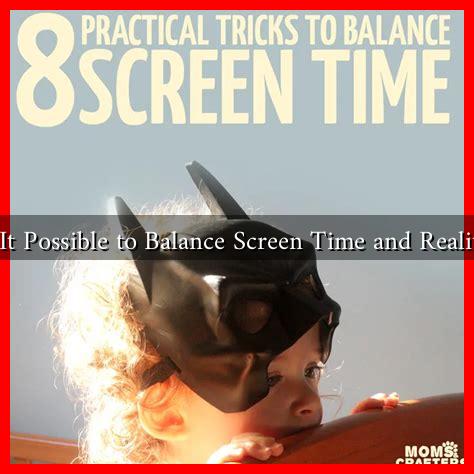-
Table of Contents
Is It Possible to Balance Screen Time and Reality?
In an age where screens dominate our daily lives, the question of balancing screen time with real-world interactions has become increasingly pertinent. With the rise of smartphones, tablets, and computers, many individuals find themselves grappling with the challenge of managing their digital consumption while maintaining meaningful connections in the physical world. This article explores the implications of excessive screen time, offers strategies for achieving balance, and highlights the importance of fostering real-life relationships.
The Impact of Excessive Screen Time
Research indicates that excessive screen time can lead to a variety of negative outcomes, both physically and mentally. According to a study published in the journal JAMA Pediatrics, children and adolescents who spend more than two hours a day on screens are at a higher risk for issues such as obesity, sleep disturbances, and behavioral problems. Adults are not immune either; prolonged screen exposure can lead to:
- Eye strain and discomfort, often referred to as digital eye strain or computer vision syndrome.
- Increased anxiety and depression, particularly linked to social media use.
- Reduced physical activity, contributing to a sedentary lifestyle.
These findings underscore the importance of monitoring screen time and its effects on overall well-being.
Finding the Right Balance
Achieving a balance between screen time and reality is not only possible but essential for maintaining mental and physical health. Here are some effective strategies to consider:
- Set Time Limits: Designate specific times for screen use and stick to them. For instance, limit recreational screen time to two hours a day.
- Engage in Physical Activities: Replace some screen time with physical activities such as walking, jogging, or joining a local sports team. This not only reduces screen exposure but also promotes health.
- Prioritize Face-to-Face Interactions: Make a conscious effort to engage in real-life conversations with friends and family. Schedule regular meet-ups or family game nights to strengthen bonds.
- Practice Mindfulness: Incorporate mindfulness techniques to help you become more aware of your screen habits. Apps like Headspace or Calm can assist in developing a more mindful approach to technology use.
Case Studies: Success Stories
Several individuals and families have successfully navigated the challenge of balancing screen time with reality. For example, the New York Times featured a family that implemented a “screen-free Sunday,” where all family members engaged in outdoor activities, board games, and cooking together. This initiative not only reduced their screen time but also strengthened their family bonds.
Another case study involves a high school that introduced a “digital detox” week, encouraging students to unplug from their devices. The results showed a significant increase in student engagement, improved mental health, and enhanced academic performance. These examples illustrate that with intentionality and commitment, it is possible to create a healthier relationship with technology.
The Role of Technology in Moderation
Interestingly, technology can also aid in achieving balance. Numerous apps and tools are designed to help users monitor and limit their screen time. For instance:
- Screen Time (iOS): This built-in feature allows users to track their app usage and set limits.
- Forest: An app that encourages users to stay off their phones by growing virtual trees as they focus on real-world tasks.
- StayFocusd: A browser extension that limits the amount of time spent on distracting websites.
By leveraging these tools, individuals can cultivate a more balanced approach to screen time.
Conclusion
In conclusion, while the prevalence of screens in our lives presents challenges, it is entirely possible to balance screen time with reality. By setting limits, prioritizing face-to-face interactions, and utilizing technology mindfully, individuals can foster healthier relationships with both their devices and the people around them. The key takeaway is that moderation is essential; embracing the digital world while remaining grounded in reality can lead to a more fulfilling and connected life.

